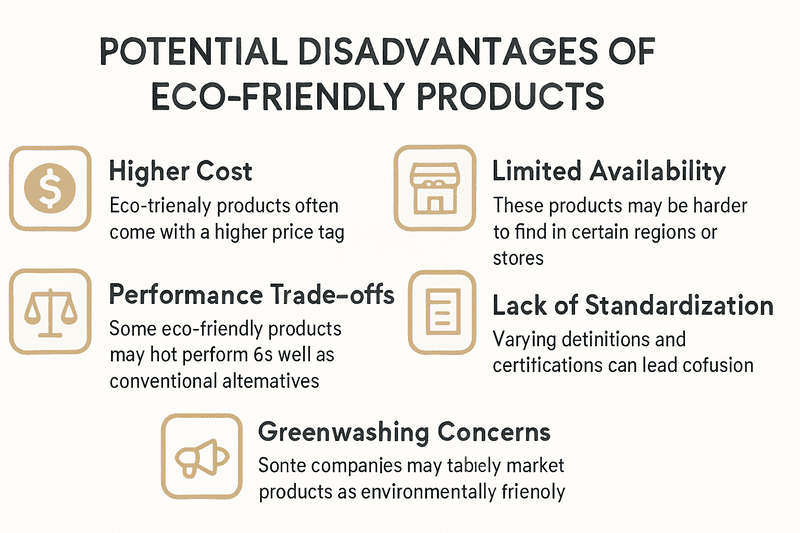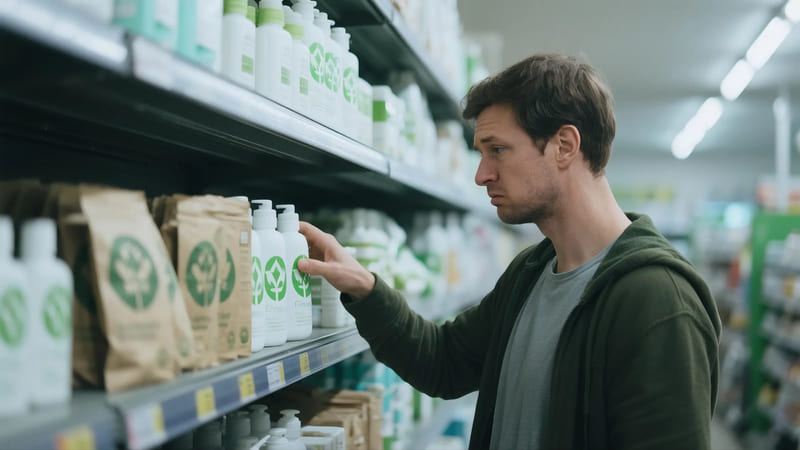Many of us aspire to make more sustainable choices, yet often find ourselves not purchasing eco-friendly products despite good intentions. Understanding the primary barriers can help both consumers and brands bridge this gap.
The main reasons consumers may not buy eco-friendly products often revolve around higher price points, perceived lower performance or efficacy compared to conventional alternatives, lack of availability or convenience, skepticism about green claims (greenwashing), or insufficient information about the product’s actual environmental benefits.
While the desire to be eco-conscious is strong, practical considerations and perceptions play a huge role in purchasing decisions. As a packaging manufacturer with ShineTop, we’re increasingly working with brands to develop sustainable packaging, and understanding these consumer hurdles is vital for us to help them succeed. Let’s explore these common reasons.
What are the Disadvantages of Eco-Friendly Products?
While "eco-friendly" sounds inherently positive, products marketed this way can sometimes come with perceived or actual disadvantages from a consumer’s point of view, which can act as barriers to purchase.
Disadvantages of eco-friendly products can include higher cost, perceived or actual lower performance (e.g., a natural cleaner that doesn’t seem as strong), limited availability or variety, shorter shelf life for some natural formulations, different aesthetic or sensory experiences (which may not appeal to all), and sometimes, confusion about their true environmental benefits or how to dispose of them correctly.
These disadvantages, whether real or perceived, can make consumers hesitate.
Common Perceived or Actual Disadvantages:
-
Higher Price Point:
- Often the most significant barrier. Sustainable sourcing of materials, ethical production, smaller scale of manufacturing, R&D for new eco-materials, and certification costs can lead to a higher retail price.
- Consumer Thought: "It’s too expensive for my budget, even if I want to be green."
-
Perceived Lower Performance or Efficacy:
- Consumers may worry that natural or eco-friendly alternatives (e.g., cleaning products, personal care) won’t work as effectively as conventional, chemical-laden ones.
- Consumer Thought: "Will this natural deodorant actually work all day?" or "Will this plant-based detergent get my clothes truly clean?"
-
Availability and Convenience:
- Eco-friendly options may not be as widely available in mainstream stores, requiring consumers to seek out specialty shops or order online (which can involve shipping costs and delays).
- The range of choices might also be more limited.
- Consumer Thought: "I can’t find it easily, or there aren’t many options to choose from."
-
Different Aesthetic or Sensory Experience:
- Natural products might have different textures, scents (or no scent), or appearances than what consumers are used to (e.g., less lather in a natural shampoo, earthier colors).
- Packaging might be more minimalist or rustic, which appeals to some but not others seeking a more luxurious feel.
- Consumer Thought: "It doesn’t feel/smell/look like what I’m used to."
-
Shorter Shelf Life (for some products):
- Products made with fewer or milder preservatives might have a shorter shelf life once opened, requiring faster consumption.
- Consumer Thought: "Will I use it up before it goes bad?"
-
Durability (for some non-food items):
- Some eco-friendly materials might be perceived as less durable than their conventional plastic counterparts (though this is not always true, e.g., stainless steel).
-
Confusion or Skepticism ("Greenwashing"):
- Consumers can be wary of vague "eco-friendly" claims and unsure if a product is genuinely sustainable or just marketed that way.
- Unclear disposal instructions for new types of "eco" packaging can also be a barrier.
Addressing these perceived disadvantages through clear communication, product innovation, and accessible pricing is key for brands wanting to increase adoption of their eco-friendly offerings.
What are Problems with Eco-Friendly Products?
Beyond individual consumer perceptions, there are broader systemic or practical problems that can sometimes be associated with the production, marketing, or lifecycle of products labeled "eco-friendly."
Problems with eco-friendly products can include "greenwashing" (misleading environmental claims), higher production costs leading to affordability issues, challenges in scaling up sustainable material supply chains, lack of adequate recycling or composting infrastructure for some "eco" packaging, and potential trade-offs where a product is eco-friendly in one aspect but not another (e.g., a bio-plastic that isn’t easily recyclable and requires industrial composting).
It’s important to look critically at the entire ecosystem surrounding eco-friendly products.
Systemic and Practical Challenges:
-
Greenwashing:
- Brands making vague, unsubstantiated, or misleading claims about their environmental benefits to attract conscious consumers. This erodes trust in genuine eco-friendly products.
-
Cost & Scalability:
- Sustainably sourced raw materials, ethical labor practices, and innovative eco-technologies can be more expensive, especially at smaller scales.
- Scaling up the supply chain for new sustainable materials (like hemp plastic or mycelium packaging) takes time and investment.
-
Performance Trade-offs (Sometimes):
- While many eco-products perform excellently, some early-generation or poorly formulated ones might not match the efficacy of conventional counterparts, creating a perception issue.
-
Lifecycle Assessment Complexity:
- Determining if a product is truly "eco-friendly" requires a comprehensive Life Cycle Assessment (LCA), considering everything from raw material extraction, manufacturing, transport, use, to end-of-life. This is complex and not always transparent.
- A product might be good in one area (e.g., made from renewable resources) but have a high carbon footprint in another (e.g., long-distance shipping).
-
End-of-Life Infrastructure Gaps:
- A package might be "compostable," but if consumers don’t have access to industrial composting facilities (or don’t home compost correctly), it may end up in landfill anyway, where it might not break down as intended.
- Similarly, some "recyclable" innovative materials may not yet be accepted by all municipal recycling programs.
-
Consumer Confusion & Behavior:
- Consumers may not understand how to properly use or dispose of new eco-friendly products or packaging, leading to unintended negative consequences (e.g., putting compostable plastic in the recycling bin).
-
Unintended Consequences:
- For example, a shift to certain bio-based materials could potentially compete with food crops for land use if not managed sustainably.
Addressing these problems requires industry collaboration, stronger regulations against greenwashing, investment in infrastructure, and clear consumer education. At ShineTop, when we propose sustainable packaging solutions like PCR plastics or FSC-certified paper, we aim to be transparent about their benefits and any end-of-life considerations.
What are the Disadvantages of Being Environmentally Friendly?
While the overarching goal of being environmentally friendly is positive, individuals and businesses can face certain challenges or perceived disadvantages in adopting greener practices and products.
For consumers, disadvantages of being environmentally friendly can include higher costs for sustainable products, the need to change established habits, limited availability or convenience of eco-options, and sometimes investing more time and effort (e.g., researching products, properly sorting waste, composting). For businesses, it can mean higher initial investment in sustainable practices, R&D costs, and navigating complex supply chains or regulations.
Adopting an environmentally friendly lifestyle or business model, while beneficial in the long run, can present hurdles.
Challenges Faced by Consumers:
- Financial Cost: Often, sustainable alternatives (organic food, eco-friendly clothing, green energy) come with a premium price tag.
- Time & Effort: Researching sustainable options, finding specialty stores, mending items instead of replacing, composting, or properly sorting complex recyclables can take more time and effort.
- Convenience & Availability: Eco-friendly choices may not always be the most convenient or readily available in all locations or for all needs.
- Lifestyle Adjustments: May require changing deeply ingrained habits (e.g., reducing meat consumption, flying less, giving up certain conveniences).
- Information Overload & Skepticism: Sifting through claims and avoiding greenwashing can be challenging.
- Perceived Sacrifice: Sometimes, eco-friendly alternatives might be perceived as less effective, less luxurious, or less aesthetically pleasing (though this is changing rapidly).
Challenges Faced by Businesses:
- Initial Investment Costs: Transitioning to sustainable materials, investing in greener technologies, or reconfiguring supply chains can require significant upfront capital.
- Higher Operating Costs: Sustainably sourced materials or ethical labor practices can sometimes be more expensive.
- R&D for Sustainable Innovation: Developing new eco-friendly products or packaging is resource-intensive.
- Supply Chain Complexity: Sourcing certified sustainable materials can be more complex than using conventional ones.
- Regulatory Navigation: Keeping up with evolving environmental regulations and certification requirements.
- Consumer Education: Businesses often need to invest in educating consumers about the benefits and proper use/disposal of their eco-friendly products.
- Risk of Greenwashing Accusations: If claims are not well-substantiated.
Despite these challenges, the long-term benefits of environmental responsibility—for the planet, for brand reputation, and often for long-term cost savings (e.g., through resource efficiency)—are increasingly outweighing the initial disadvantages for both consumers and businesses.
What Challenges Do You Face When Trying to Purchase Environmentally Friendly Products?
As a consumer actively trying to make more environmentally friendly purchases, you’ll likely encounter a specific set of obstacles that can make the process frustrating or difficult.
Common challenges faced when trying to purchase environmentally friendly products include: 1. High Price Points (affordability). 2. Difficulty Verifying Claims (greenwashing, lack of transparency). 3. Limited Availability & Accessibility (not in mainstream stores). 4. Lack of Clear Information & Labeling (confusing symbols, unclear benefits). 5. Perceived Performance Issues. 6. Overwhelming Number of Choices & Certifications.
These challenges often form the gap between good intentions and actual eco-friendly purchases.
Specific Hurdles for Conscious Consumers:
- Price Premium: This is often the biggest hurdle. Eco-friendly products frequently cost more, making them inaccessible for some budgets.
- Information Gaps & Greenwashing:
- It’s hard to know if a product is genuinely "eco-friendly." Vague terms ("natural," "green," "earth-friendly") without clear definitions or certifications are common.
- Lack of transparency about sourcing, manufacturing processes, or full lifecycle impact.
- Availability & Convenience:
- Finding a good range of eco-friendly options in local supermarkets or mainstream retailers can be difficult. Often requires trips to specialty stores or online research and ordering.
- Confusing Labels & Certifications:
- The plethora of different eco-labels and certifications can be overwhelming and hard to understand. What does each one really mean?
- Disposal instructions for innovative packaging can be unclear (e.g., "Is this specific bioplastic recyclable or compostable in my area?").
- Perceived Efficacy Concerns:
- Worrying that the eco-friendly version (e.g., natural cleaner, organic shampoo) won’t perform as well as the conventional product they are used to.
- Habit & Brand Loyalty:
- It can be hard to break away from familiar brands and products, even if less sustainable options.
- Time Constraints:
- Researching products, comparing options, and understanding claims takes time that busy consumers may not have.
- Aesthetic or Sensory Preferences:
- Sometimes the look, feel, or scent of an eco-friendly product might not align with personal preferences developed from using conventional products.
My client Anna in Thailand, who produces natural cosmetics, actively tries to address these challenges for her customers. She uses clear labeling for her sustainable packaging (which ShineTop helps her source), provides transparent ingredient information, and ensures her products are effective while maintaining an accessible price point for her market. This helps build trust and makes it easier for her customers to choose her eco-friendly line.
Conclusion
The primary reasons consumers may not buy eco-friendly products often boil down to cost, perceived performance, availability, and a lack of clear, trustworthy information. While the desire to make sustainable choices is growing, overcoming these practical and perceptual barriers is crucial. For brands, this means focusing on transparency, genuine product efficacy, accessible pricing where possible, and clear communication about the environmental benefits and proper end-of-life handling of their products and packaging.












